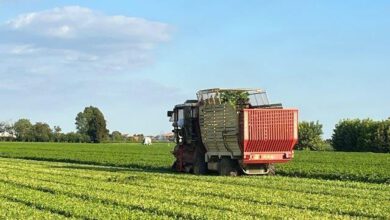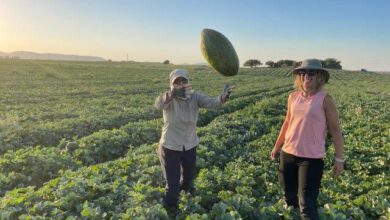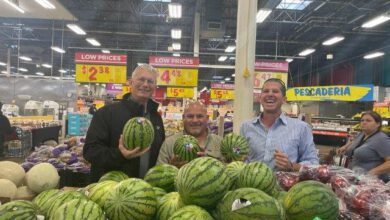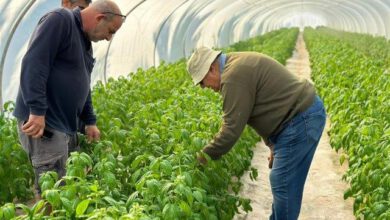The role of the Israeli Gene Bank in facing climate change
Ten years to the Israel Plant Gene Bank - Wheat provides a classical regional example for the decline of genetic diversity
Dr Einav Mayzlish Gati* einavm@volcani.agri.gov.il

the israel plant gene bank (igb) of the agricultural research organization (aro) is the national center to conserve the genetic resources of regional vegetation. the igb is a physical repository for collected seeds for current and future uses and development, and is also part of the collection and conservation program for wild plant and landrace seeds from natural habitats all over israel.
the wealth and diversity of land of israel plant life is in danger due to habitat loss caused by intensive urbanization, infrastructure construction and the rapid transition to modern agriculture based on elite lines with extremely limited genetic diversity.
the united nations food and agriculture organization (fao) has issued frequent warnings in recent years of an anticipated global food crisis. rising temperatures and extreme climactic changes in part may affect the amount and quality of available precipitation for agricultural crops. different forecasts suggest that the occurrence of agricultural pests and disease will also increase due to climatic changes. to ensure food security, agricultural plant breeders must today develop crop varieties that can withstand changing environmental conditions.
new agricultural varieties must be cultivated to withstand extreme climatic changes, beyond a narrow focus on crop quantity or quality. plant breeders today must emphasize resilience to climatic changes: extreme temperatures, short and intense rainfall regimes, and changing diseases. wild plants and landraces are vast repositories of genetic diversity for crop improvement. their genetic variety can improve crop adaptability to current and future environmental challenges.
the igb collection preserves genetic variety and is one of the essential components for the preservation of the genetic biodiversity of israeli flora. israel contains some of the richest variety of plant species found in the world. the region is recognized as the center of genetic diversity and is characterized by the abundant presence of crop wild relatives(cwr) of grains (wheat, barley, oats), legumes (peas, lentils, chickpeas), fruit trees (plum, pear, fig), vegetables (garlic, carrot, cabbage), aromatic plants (sage, fennel, hyssop), and productive plants (flax, clover, alfalfa). cwr are defined by the european crop wild relative diversity assessment and conservation forum as wild species closely related to food and fodder crops, and by extension, forestry species, ornamental and industrial crops, and other species of socio-economic importance (such as medicinal and aromatic plants), to which the wild relatives may contribute genetic material. the igb holds 95% of the 370 different cwr native to israel.
cwr have long been known for their importance. they have great value to agriculture and forestry, both of which have benefited for millennia from cwr genes that confer, for example, pest and disease resistance, drought tolerance, and other advantages sought by agriculture globally. cultivars of modern crops are genetically uniform, which underscores the necessity of developing new resistant and better-adapted cultivars that incorporate wild relatives’ genetic advantages. high demand for new cultivars must be met by obtaining novel genes from wild relatives.
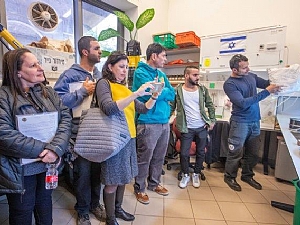 |
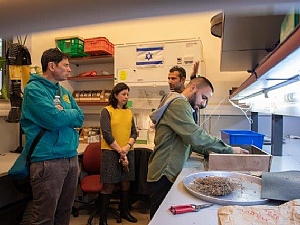 |
crop landraces of israel
israel also contains heirloom species (landraces) that were cultivated in the fertile crescent thousands of years ago. these crop landraces dynamically adapt to environmental conditions, contain broad genetic diversity and produce predictable harvests. these landraces are disappearing due to the ongoing extinction of agricultural biological diversity. the objective of igb is the long-term preservation of seeds that can be made available to plant breeders and researchers for many years to come.
landraces are dynamic populations that evolve over generations, due to natural and human selection for adaptation to local environments, produce stable yields, and contain extensive genetic diversity and buffering capacity. over the 20th century, landraces in israel and all over the world were replaced by a very small number of “modern” varieties bred and grown in high-input industrial farming systems for uniformity, high yield, and suitability for mass food production. local landraces that evolved considerable genetic diversity for adaptability and resilience, as well as high nutrient content and rich and varied flavors, are in danger of extinction.
wheat provides a classical regional example for the decline of genetic diversity. since the early 20th century, wheat genetic diversity has been sharply eroded by the persistent genetic selection for high and stable yields, as well as the quality requirements of the flour milling and baking industries. modern wheat strains are based on a small number of high-yield varieties with narrow and fragile genetic diversity, while traditional wheat strains contain a genetic diversity developed over thousands of years through selection by traditional agriculture in different environments.
in the late 19th century hundreds of traditional wheat strains were cultivated in israel. during the 20th century, these were replaced by a small number of modern “semi-dwarf” strains that were cultivated for their high yields, uniformity, capacity for intensive agricultural management with high inputs (synthetic, usually chemical fertilizers, pesticides, etc.), and suitability for mass food production. as intensive agriculture expanded, semi-dwarf bread wheat strains (triticum aestivum) were introduced in the 1960s and 1970s, and traditional strains were discarded from the seed map in israel. by the 1980s, traditional wheat strains had been entirely abandoned. these factors have led to the disappearance and near extinction of traditional strains of genetically diverse israeli wheat.
the igb maintains a unique collection of local landraces that have been collected since the beginning of the 20th century. these were deposited in the igb and other gene banks globally, and are now exported back to israel and provide israeli and international researchers with access to important pools of traits and genes for better research and breeding in the face of climate change pressures and growing food demand.
* head of the israeli gene bank igb, agricultural research organization – volcani center

